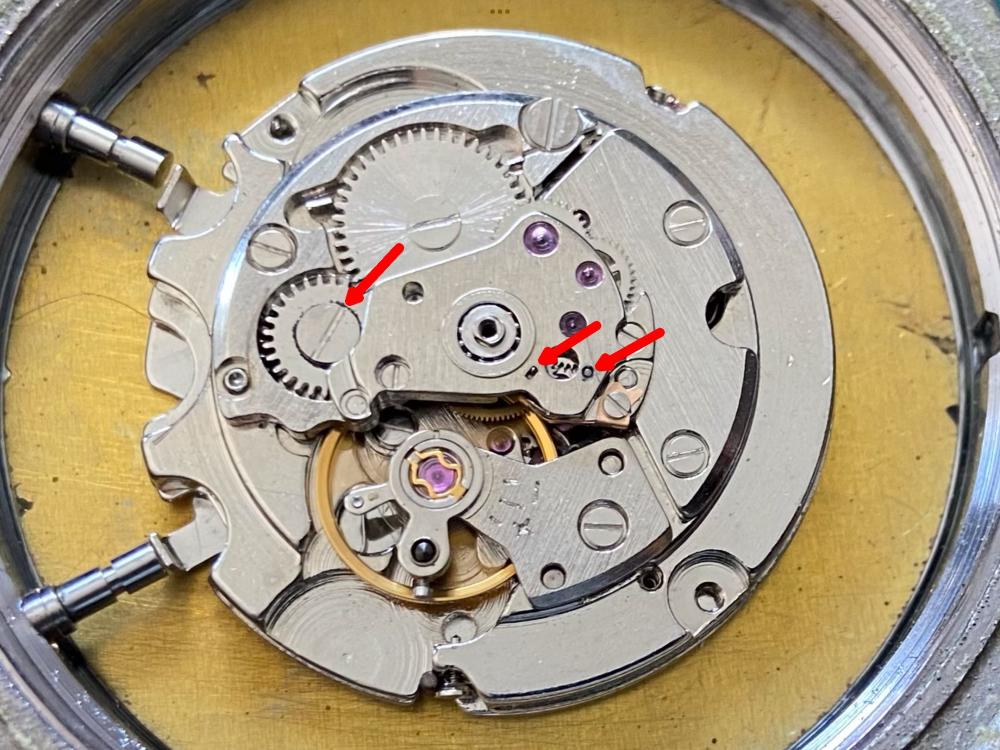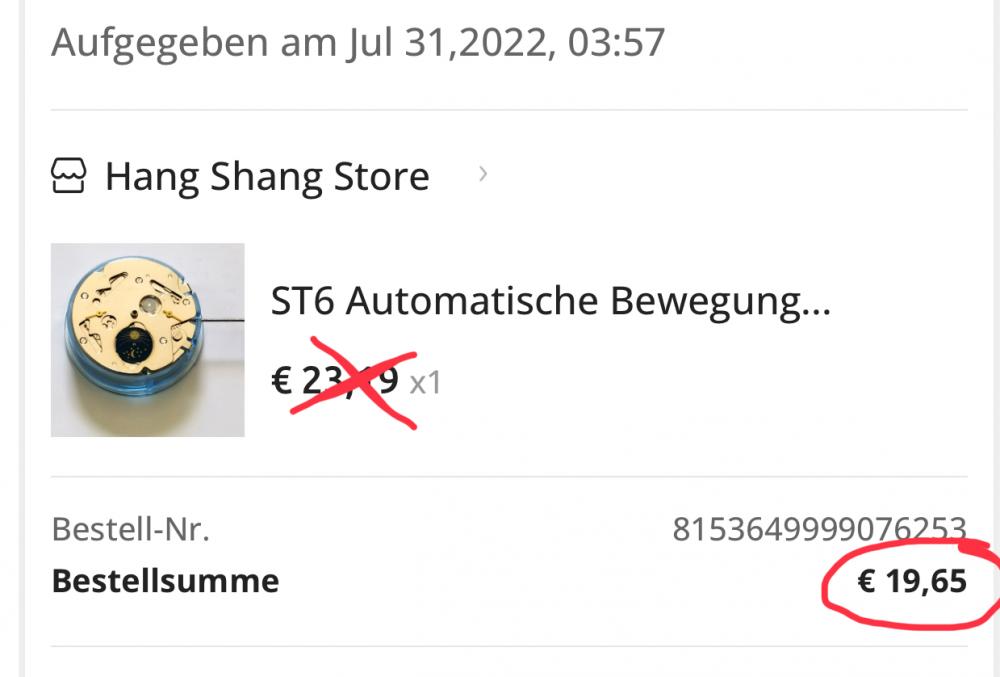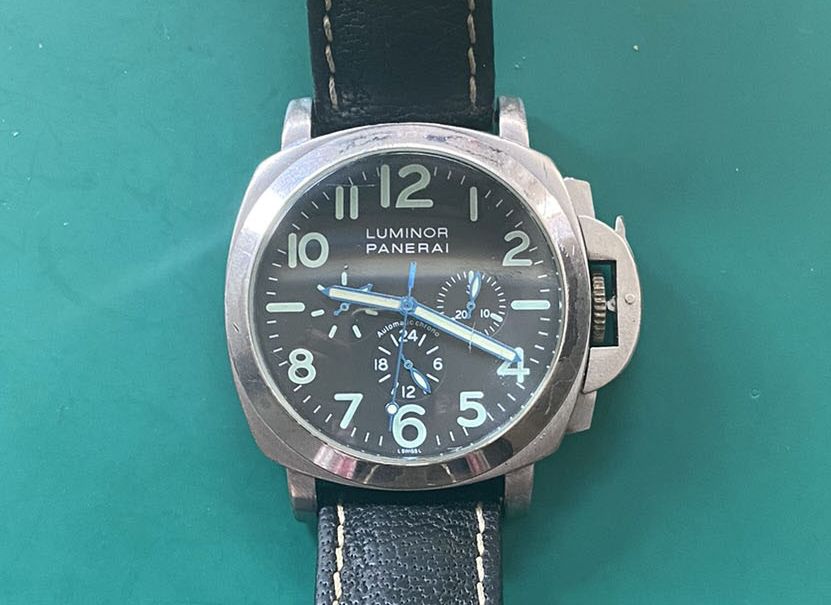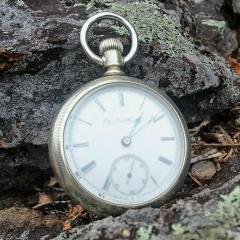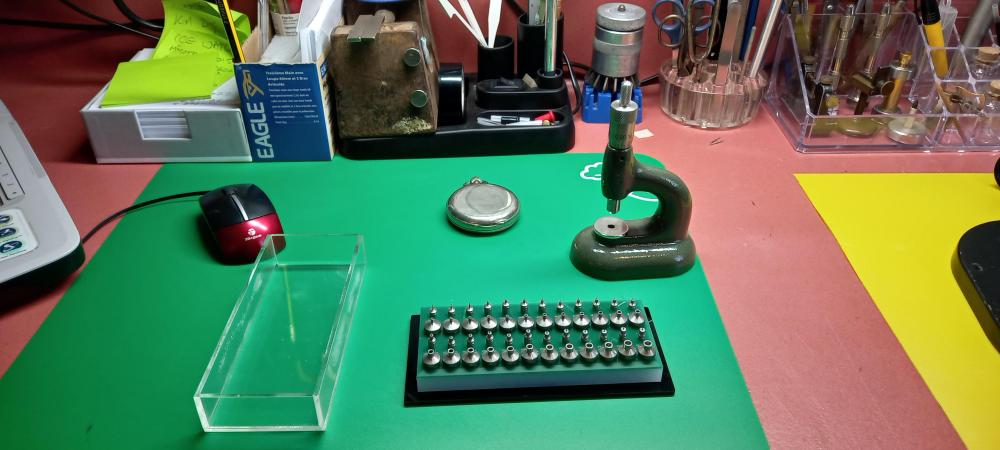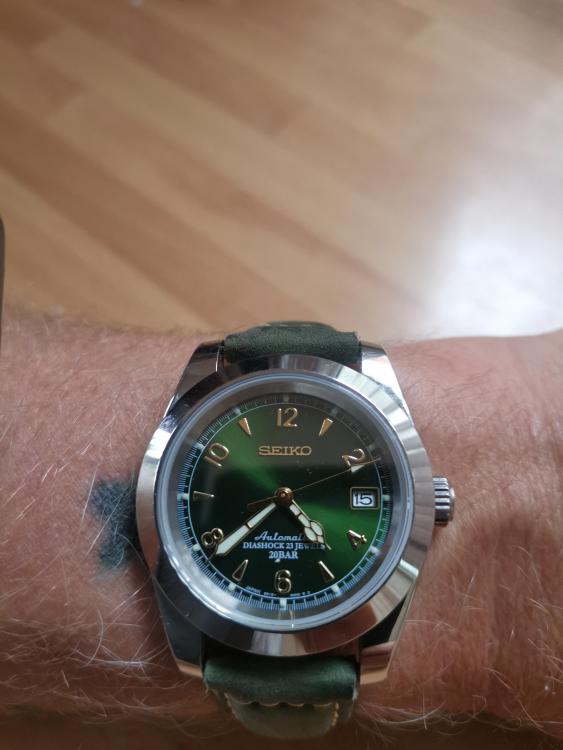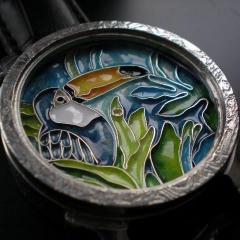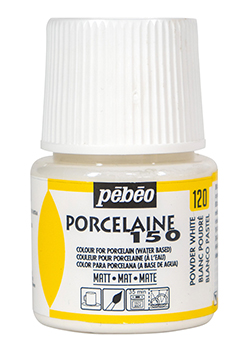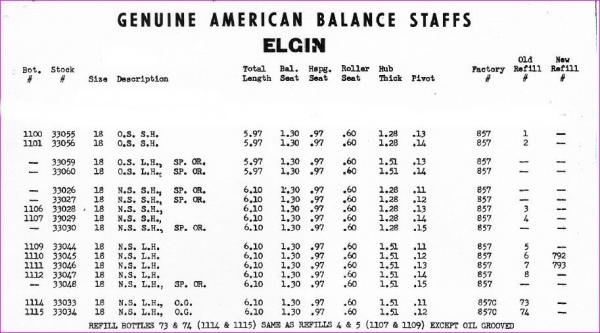Leaderboard
Popular Content
Showing content with the highest reputation on 08/30/22 in all areas
-
A friend of mine gave me his 15 year old clone for repair. Looking through the windowed back I found a Seagull ST6S (No. 6502). The oscillating weight seemd to be engraved nicely but turns out to have a decal only My friend complained that the minute hand didn't match the hour hand anymore as you might see at this pic: After having removed the hands and dial it looked like that: The movement was dry and partially worn around the crown wheel and the autowinder gears. So I disassambled it completely for a service. Inside the barrel I found a partially broken mainspring which had to be replaced. Cousins had a matching spring for about 20 bucks (incl. tax ans shipping). But Ali had a completely new movement for the same price With the new movement (which seemed to be factory oiled correctly) the watch is running acceptable (but major differences in amplitude and speed between horizontal and vertical positions). Nevertheless my friend is happy. So am I3 points
-
Good news. I have amplitude!! I decided to file the stud while attached to the cock. It was easier that way. I went searching through my dad's files and he must have known I needed it--found a super fine file that worked perfectly. The watch is running slowly, but I can remove a couple of screws to speed it up. That is the next step. BTW, I reverted back to the original balance and the staff that I made. I feel pretty good about that.3 points
-
For cases and straps, your approach is fine, Larry. On DIY solution for cases and metal bands is to use a small amount of dishwashing liquid and a few drops of ammonia as a cleaning solution in the ultrasonic. For watch parts, using a small jar in a water bath in the ultrasonic is great. You may want to get some little baskets to keep the parts separated. You should be using a cleaner, and then at least one rinse. VM&P Naphtha ia a good watch parts cleaner and degreaser, and the 91% alcohol is an OK rinse. Do not leave watch parts in the alcohol for more than 30 secs, and don't heat the alcohol rinse. Alcohol can dissolve the shellac that is used to hold jewels in place on the balance and pallet fork. Watch cleaning systems usually use one cleaning jar, then two or three rinse jars. Two rinses should be fine for a start. I use watch cleaning solutions, but that may be too much of an investment to start with. I usually get it from Esslinger, but they don't have it right now. https://zenithsolutions.webs.com/hi-tech-and-hi-solv Hope this helps.2 points
-
No. I just put half a tsp of each into jam jar filled it with enough water to dissolve it. It was probably quite concentrated. I sometimes mix dry citric acid, oxalic acid and scouring powder and add a little water to make a paste for scrubbing out stubborn dirt around the house, like soap scum in the shower, calcium deposits around the base of the taps, etc.2 points
-
Lol its probably not difficult to control. Both these watches were quite old and another poker's intervention could have influenced the issue. Although my sister's had never been touched inside and barely worn and the oil was still fluid. She stopped wearing it years ago and only wore it very occasionally anyway. Also an everite so of reasonable quality. She had to shake it to make it start up. I assume because the beat was so far out , i would have to guess it had moved easily while wearing. It was very easily moved back into correct beat. I'm sure it had come straight from the factory like this, everything else was perfect. Ps. You are safe shane my missus has had her rant of the day today, at her mum and sister, it was very funny. People have to be very bad for me let her off her lead . I also hope we have not frightened the OP away.1 point
-
I just use distilled water with some dish soap for cases and bracelets and Elma Red for watch parts with a rinse in 99% IPA, Obviously not putting the balance and palette forks in this solution, they go in Essence of Renata.1 point
-
another popular cleaning solution company would be L&R available from the same sources as Zenith. Also available and I don't see Zenith on Amazon. https://www.lrultrasonics.com/industries/jewelry-watches1 point
-
Interesting. I have not experienced any regulators that loose. I also wouldn't have thought their fit to be one of the harder things a manufacturer needed to control. @Neverenoughwatches No worries. I wouldn't want you to send your missus to see me. Thanks for your input. Shane1 point
-
yes I've seen the blue Elma machines that other than the case do appear to be identical to Witschi I think sometimes at a lesser price at least in the European countries where they appear. then as nice as the witschi microphone is which is very nice I would agree the fact that it cannot rotate 365° is definitely a problem or perhaps an annoyance. the new microphones definitely looked interesting. There specifications say a 45° angle so would do dynamic poising much nicer. Doesn't say whether you can rotate them continuously around without tangling up the cord though. Then it looks like the capable of actually being adjusted to do timing in 12 separate positions. So they've definitely upgraded the microphone.1 point
-
Strike side of a Smiths Enfield strike Fan Warning wheel with pin Gathering pallet wheel Star wheel Great wheel Barrel1 point
-
I just serviced an AS 984 (1930s-50s?) which doesn't have shock protection, but surprisingly has a moveable balance stud holder. I managed to dislodge it (2 times ) whilst turning the regulator boot, so it was quite lose and easily moved. It would move as I pushed the regulator. I think it could move with a shock to the watch - but that might break the balance staff pivots. I have a Seiko 7S26, SNK809. To give you an idea of performance, I just wound it and put it on the timegrapher. It's showing 240° dial up (not bad for one of these movements!) and a steady 220° crown down. 20° loss from DU to CD sounds pretty good to me.1 point
-
1 point
-
I'm hoping Old Hippy steps in soon. He'll know more. But I did happen upon this advertisement while poking around: https://dartsilverltd.co.uk/product/brass-carriage-clock-vintage-acg-huber-w-j/ Hopefully this will be a step in the right direction.1 point
-
https://r.search.yahoo.com/_ylt=AwrIQhFu6w1jzIAABBF3Bwx.;_ylu=Y29sbwMEcG9zAzIEdnRpZAMEc2VjA3Ny/RV=2/RE=1661885423/RO=10/RU=https%3a%2f%2fmb.nawcc.org%2fthreads%2fseiko-faceted-watch-crystal.148038%2f/RK=2/RS=h3H_EAgYQQjipiMs5c4jMxqtwvk- The problem of obtaining faceted crystals was discussed here at the NAWCC. have a read you may be able to glean somthing of use. https://r.search.yahoo.com/_ylt=AwrIQhFu6w1jzIAADRF3Bwx.;_ylu=Y29sbwMEcG9zAzQEdnRpZAMEc2VjA3Ny/RV=2/RE=1661885423/RO=10/RU=https%3a%2f%2fwww.watchmaterial.com%2fseiko-crystals%2f/RK=2/RS=nqn2V8ZlISvEZUhr46jxwsEAvXA- This site may be able to help1 point
-
Hi rd. The hairspring is the time regulator of a watch. A very fragile and temperamental component, that needs to be true and accurately shaped without obstruction and contamination to enable good timekeeping. A fairly common issue of magnetism can affect the hairspring by making the coils momentarily stick together while it is expanding and contracting. In a way this could be considered as contamination be it somewhat by an invisible substance. This can cause the watch to gain time as the coils are pulled in faster on contraction. Normally a more increase of time gain than a few minutes would be experienced due to magnetism contamination. But i suppose it could vary depending on how the hairspring is reacting. This is only one possible cause. Contamination from the watch's own lubrication can also cause timing issues. A knock or jolt to the watch could possibly move a lesser frictioned regulator of time or beat. This is the first area of possible issue that you would need to be looking at. With at least a 10x plus loupe inspect the hairspring while the watch is running. Looking for any sign of contamination. The hairspring should look central and evenly coiled up until the end curve which will have a double kink and then widen out as it passes through the regulator pins and then on up to the stud fastening point. It should be breathing in and out evenly and regularly. If its looking bunched up and uneven then you may have disturbed a loose etachron adjuster while you were trying to regulate the watch back into better timing. Also look for the coil sticking and releasing. Report back when you've looked at these points.1 point
-
If that amplitude is correct, then it is very low. I wouldn't rely on working out the amplitude by filming it with slo-mo. But you have given us nothing about the watch, how old it is, when the last time it was serviced. A 1917 trench watch might be good to go with low amplitudes, but not a modern ETA 2824-2. Unless you have some sort of timegrapher, I wouldn't rely on visual guesswork regarding the amplitude. Amplitude isn't measured as the full swing of the balance to full swing of the balance. It's measured as the balance at rest (as the impulse jewel is between the banking pins with no power on the mainspring) to the full swing of the balance. So, you might be thinking the amplitude is something other than it is1 point
-
Hello and welcome to the forum A nice collection , next collection will be tools and Horological Items ( a rabbit hole) beware its addictive1 point
-
1 point
-
1 point
-
1 point
-
There are many years of thread posts in this "General" sub-forum. In an attempt to better organize and categorize these threads I have created a number of sub-forums within the main category of "Watch Repair Discussions, Help & Advice" over time (a long time as it's a painful job), many of the posts within this General sub-forum will be moved to a more appropriate sub-forum depending on the subject. Please help by taking a quick look at the sub-forum titles and post in the appropriate section and as a last resort, if you do not find an appropriate sub-forum for your subject then you may post here. Thank you for your co-operation1 point
-
I think this post was intended for the lighter fluid thread rather than the mainspring barrel thread (I split them off) so I've moved it here for continuity reasons - I hope you don't mind. For those confused - I apologize but this thread went off on a tangent and so I split it in an effort to keep threads on topic. The split thread is here:1 point
-
Hi 12. This topic has been discussed many times over here so some searching for previous info and people's experiences will give you a good insight of how to use lighter fluid. But in the meantime here is some to get you moving. There are obviously better specific proprietary fluids for cleaning but as a starter the light fluid is ok and was also my starting point with cleaning. So just to give you a little background on the substance you are using. Lighter fluid is a type of naptha which is petroleum ether. There various grades of naptha that all have different uses. The gradings are established according to their molecular structure, with two basic categories which are made up of a light and a heavy naptha. Light naptha is made up of a low carbon to hydrogen structure, heavy naptha has a high carbon molecule structure. In reference to cleaning, light naptha evaporates more quickly than a heavy naptha. You can do your own test here with a couple of drops on a mirror, this will also show you any residue left behind as an indication as to its purity. Lighter fluid often contains vm and p naptha with is varnish makers and painter's naptha. This has a higher count carbon atom structure so is a heavy naptha and does not evaporate as quickly as a light naptha. The time length of soak depends on how dirty the parts are. 10 mins with agitation and brushing can be enough or an overnight soak maybe required if heavy contamination is present. Watchpaper and a blower is fine for drying, just be mindful that tiny springs can fly, so consider some method of containment here. Enjoy your first experience of servicing1 point
-
1 point
-
1 point
-
Very nice, I've always wanted to build a green watch. Can I ask where you purchased that fab dial? The sunburst on it is superb.1 point
-
Following this thread. I like the look of the repair. I have used Bergeon powdered repair enamel. It only comes in brilliant white and is rather pricey. I have had to repaint Roman numerals before and I used black drafting ink and a 000 (triple ought) brush, which I had to thin down even further with a wee bit of plucking.1 point
-
1 point
-
The most important thing when restaffing is to measure the old balance staff. This way you can verify the new staff matches the old staff. So the abbreviations are for new style and old style.. Then you have short or long hub. So if you measure your staff compared to the information I have you should be able to figure out what you need. Then the reason why all the different pivots sizes usually have to do with the number of jewels of the watch. In other words a seven jewel watch will usually have a large pivoted staff 21 jewel will usually be the finest. So ideally be nice to measure the pivots.1 point




